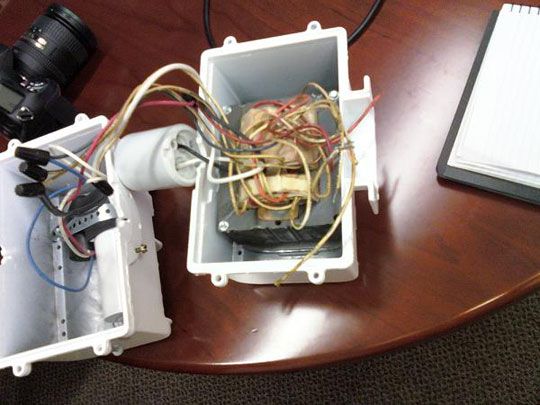Antonio Espinosa opens up a ballast – the boxy device that controls the high intensity discharge (HID) lights you see at stadiums and big box retailers – and points to a large gray cube inside of it that is a crucial component in turning on the bulb.
"It is a piece of lead. It is 70-year-old technology we are competing against," he said.
Espinosa, CEO of HID Laboratories, is hoping to replace that hunk of lead and other components with a ballast relies on digital technology, such as microprocessors and networking equipment, that can both reduce power consumption and increase the capabilities of HID lights.
The company's ballast converts current and voltage to digital signals, and then back into current and voltage, a process that allows it to fine-tune power and functions. (The picture above shows a complete lamp from HID Labs. The ballast is that white box.)
-
Where Will DOE’s Loan Program Make the Next Climate Tech Investments?
48
-
What the Frack Is Happening With Natural Gas Prices?
15
-
With an Energy Crisis Brewing, No Peak in Sight for Emissions
9
With HID's controller, a HID lamp can be equipped with a 250-watt bulb rather than a 400-watt bulb and provide an equal or even greater amount of light. Lamps equipped with the digital ballast can also be dynamically controlled (turn them on or off or have them dimmed) – these are capabilities that traditional HID lights don't have. (The company's intellectual property mostly revolves around the ballast, but even so it combines the ballast with bulbs and reflectors to sell a completely packaged lamp.) Overall, HID says it can cut power bills by up to 40 percent.
The company has already installed its digital lamps at Tri-Tool, an oil equipment manufacturer in Sacramento, and a sports complex in San Jose. It is also preparing a trial with Java City to put motion sensitive HID lights in a warehouse. When a forklift or a person passes by, the lights flip on. When they leave, the lights dim. HID lights could also be rigged to control sensors for daylight harvesting.

An old-fashioned ballast. The gray piece in the center is a seven-pound block of lead. HID Labs wants to replace that with microprocessors.
HID is also talking to solar installers. Solar installers run wire up to roofs to install panels, after all. By combining energy efficient lights with new panels, an installer could serve as an energy management specialist and reduce the payback from eight or more years to four years, he argued.
"They already manage the top of the roof, so why not manage what's underneath the roof," he explains.
Last year, HID Labs discussed the technology for the first time, and now it is now discussing its commercial plans.
HID's lights are networked, which means they can provide feedback to a central computer room. A chemical sensor could be attached to a light, for instance, that would then cause the light to turn on when a chemical leak is detected.
Lighting consumes 22 percent of the electric power in the U.S. and it is not effectively deployed. Look up at an urban skyline at night: most of those lights are illuminating empty offices.
Various companies are taking on specific niches in the market. Adura Technologies and Lumenergi have developed networked dimmer controls for florescent lights. (Both HID lights and florescent lights are dimmable with current technology, but it doesn't work well and dimming has not been adopted.)
Metrolight, meanwhile, also has a HID controller. One of the chief differences between Metrolight and HID Labs is that Metrolight only sells the ballast to other manufacturers, not a complete light. The market has yet to determine which company has the best technology, but the clock is ticking.
Like several other green building technology companies, HID Labs will target schools and government buildings over the next few years as well as the business sector. Stimulus money to retrofit buildings is already flowing to schools, and utilities can include the technology in subsidy/rebate programs.
Currently, HID is doing its beta manufacturing in Menlo Park, but it will move assembly operations to a contract manufacturer in Mexico.
HID's technology originally emerged from Oak Ridge National Labs. Funding in part has come from American River Ventures and a few other firms.
